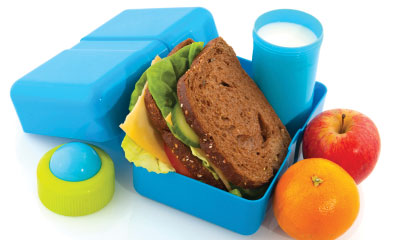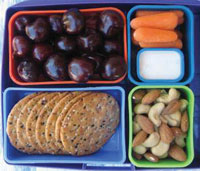 Summer’s coming, but packing lunches may still be part of your routine, as camps, picnics and family outings begin to fill the calendar. When the Seattle sun finally makes its appearance, the kids will be romping around the outdoors, and you can help protect that environment by packing an eco-friendly lunch box.
Summer’s coming, but packing lunches may still be part of your routine, as camps, picnics and family outings begin to fill the calendar. When the Seattle sun finally makes its appearance, the kids will be romping around the outdoors, and you can help protect that environment by packing an eco-friendly lunch box.
One of the biggest challenges — especially in parks, on beaches and at campsites — is feasting without leaving a trail of waste. Corporate America entices children with assortments of meat, cheese and crackers served in compartmentalized plasticware, but daily doses of these snacks will leave a pile of garbage taller than your child.
The secret to a waste-free lunch is reusable containers. Aija Christopher, an Edmonds mother of three boys, loves the flexibility of Laptop Lunches, which include a variety of plastic containers that fit neatly together like a bento box.
Corey Colwell-Lipson, green-lifestyle expert at celebrategreen.net, takes it one step further by avoiding all plastics. Even though many new containers are free of bisphenol A (BPA) and phthalates—the most recent chemicals to garner negative attention—she believes we may discover other harmful chemicals in the future.
Instead, Colwell-Lipson relies on stainless steel and, surprisingly, glass. “A tiny jam jar is great for sending carrots, cranberries or nuts. And larger jars are perfect for wraps,” she says. She reuses everything from pickle jars to tiny breath-mint tins.
A stainless steel thermos, which can be chilled or heated in advance, is an effective way to reuse leftovers from last night’s dinner. And don’t forget the fun factor: Christopher uses bamboo skewers for fruit, meats and cheeses, and has noticed that her boys eat better.
Kids can be rough on their lunch boxes, so choose one that is durable and fixable to avoid making this purchase year after year. Cloth napkins and reusable utensils complete the package, but these items need not cost much money. Colwell-Lipson uses pinking shears to cut fabric napkins out of Goodwill purchases, while Christopher has found that summer garage sales offer her boys a fun way to pick out their own stainless steel utensils.
Eco-friendly food choices
What’s inside the lunch box is equally important. Eating locally grown food reduces the amount of fossil fuels expended when the food is transported. During the summer, it’s easy to buy local with the large numbers of seasonal farmers’ markets, or even CSA (community-supported agriculture) programs that will deliver right to your door. Take your children with you to the market — where taste testing is frequently encouraged — and let them choose their favorites.
Choosing organic produce saves both your child and the Earth from pesticides, but it will cost more. One strategy to ease this expense is to rely on the “Dirty Dozen” list developed by the Environmental Working Group. Currently on the list of most-contaminated produce are many children’s favorites, including celery, apples, grapes and berries. It’s important to prioritize these foods for organic purchases.
 Carolyn Wright of Snohomish takes advantage of the many varieties of fresh produce available when packing summer lunches for her 6- and 10-year-old daughters. “We pack more seasonal fruits and vegetables, a lot of times grown from our own garden. Also, any fruit scraps are put right into the compost pile.” By encouraging your children to bring their leftover food back home, you can also determine if you’re packing foods they’re actually eating.
Carolyn Wright of Snohomish takes advantage of the many varieties of fresh produce available when packing summer lunches for her 6- and 10-year-old daughters. “We pack more seasonal fruits and vegetables, a lot of times grown from our own garden. Also, any fruit scraps are put right into the compost pile.” By encouraging your children to bring their leftover food back home, you can also determine if you’re packing foods they’re actually eating.
You’ll also create less waste by choosing the largest packages available at the grocery store and then repackaging for individual servings. Even better, stock up on dried snacks in the bulk bins. Wright’s family relies on trail mix for an easy-to-pack, energizing snack on family hikes.
Brown-bagging it
Just like on school field trips, some camps request campers to bring fully disposable “brown bags.” This poses challenges for parents trying to pack green lunches, but there are creative solutions that can help. Christopher avoids plastic bags by using butcher-block paper that she buys in bulk. “The children love to color the paper, and then I wrap their sandwiches in it.”
You may have to compromise on kids’ beverages if they need an entirely disposable lunch. Situations like these may be the time to treat the kids to a juice box, even if it isn’t the greenest choice. You can also teach your children to be aware of recycling options when they toss their bagged lunches.
If you’re only going to make one change this year, ditch the disposable plastic water bottles, which are currently being sent to our landfills at an estimated rate of 28 billion per year. Stainless steel water bottles are a must-have for families that want to keep the kids hydrated and the earth healthy.
The mountains, beaches and forests of the Northwest are just waiting to be discovered by your kids, and an Earth-friendly lunch is a perfect way to begin teaching them how to respect this environment.
Erika Parker Price blogs about green issues at ourkidsearth.blogspot.com and estimates she has packed nearly 2,000 lunches for her 9- and 11-year-old boys.









